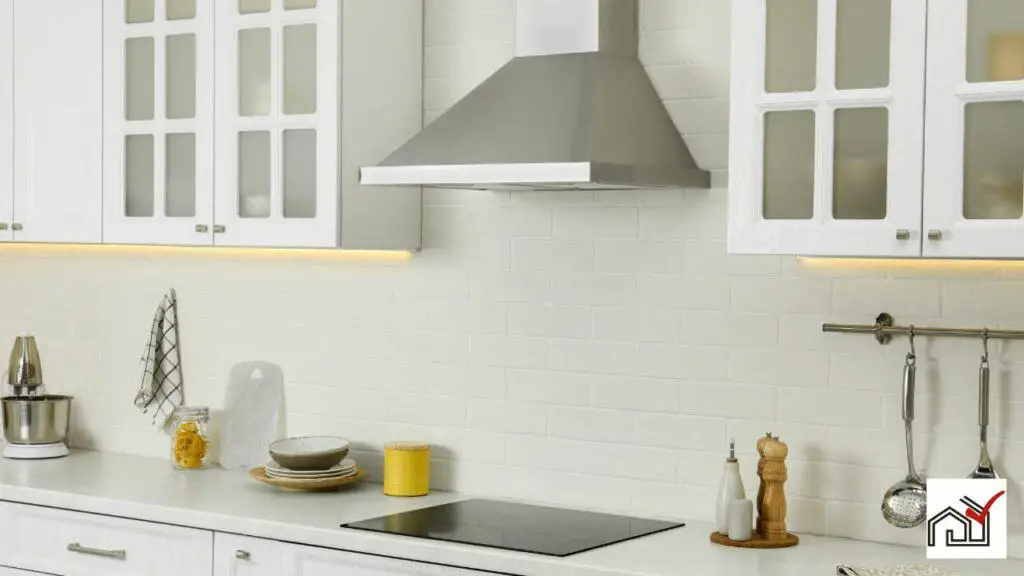The space between a hood and range should be 28 to 36 inches, following industry standards. This distance is important for effective ventilation, which helps keep the air clean and reduces the risk of fire.
The exact clearance may vary based on the hood and appliance type. Always check the manufacturer’s guidelines for the correct distance for your specific model.
Let’s now talk about the necessity of proper spacing, dangers of incorrect installation, recommended heights for different hoods, and installation advice.
Importance of Proper Spacing
Proper spacing between a range hood and cooktop is essential for safety and ventilation efficiency. The installation height depends on the cooktop height and type. Following the manufacturer’s guidelines for hood height is important to capture smoke and odors effectively and to prevent heat damage or fire. Too high an installation reduces ventilation effectiveness.
Installers should comply with local building codes for minimum hood height to prevent accidents and to make cleaning easier. The correct installation height is vital for a safe and functional kitchen, ensuring good ventilation and a long-lasting system.
Ideal Height Recommendations
Range hoods should be installed at a height that allows for effective air filtration and safety above the cooking surface. This distance is crucial for capturing smoke, grease, and odors to maintain a clean kitchen environment.
For gas cooktops, which have an open flame, install the hood between 24-30 inches above the stove. Electric stoves require a range hood height of 20-24 inches. Induction cooktops, due to their unique heat generation, can have hoods installed at 30-36 inches.
The correct installation height ensures proper ventilation and reduces the risk of accidents. The front of the hood should be aligned with the front of the stove for maximum effectiveness.
The type of range hood and its CFM rating also affect the installation height. Models with higher CFM can be installed higher above the stove, while those with lower CFM should be closer to ensure enough air movement.
Following these recommendations will help position range hoods for optimal safety and performance, enhancing the cooking environment.
Risks of Incorrect Installation
Correct installation of a range hood is essential for safety and functionality. Installing the hood too close or too far from the stove can lead to fire risks and damage to kitchen appliances. It is important to follow the manufacturer’s recommended height guidelines to ensure the hood operates safely and effectively.
Improper installation can have serious consequences. For example, if the hood is installed too low, it is susceptible to heat and flames, which could cause a fire, and damage the hood’s exterior, compromising its durability and appearance. On the other hand, installing the hood too high reduces its ability to capture smoke and grease, leading to air pollution in the kitchen and house.
A hood installed too low also accumulates grease faster, increasing the need for cleaning and maintenance, which can incur additional costs. This issue is particularly prevalent with electric stoves that produce more airborne particles at high temperatures.
To prevent these problems, the hood should be installed at the correct height above the stove. Proper installation height maximizes the hood’s efficiency and safety, protects kitchen appliances, and ensures a comfortable cooking environment without obstructing movement. Following the recommended installation guidelines can help to prevent the risks of incorrect installation and maintain a functional kitchen.
Range Hood Types and Distances
Different types of range hoods require varying installation heights above the cooktop, influenced by their design and suction capacity. Typically, the height for a range hood above an electric stove should be between 20 to 24 inches, while for a gas stove, it should be installed higher due to the presence of an open flame.
The hood’s CFM rating is a critical factor to consider; a higher CFM allows for installation at the upper end of the height range, as it can effectively capture smoke and vapors from a greater distance. A lower CFM rating necessitates a closer installation to ensure efficient operation.
It’s important to install the hood at a height that prevents heat damage and avoids fire hazards, while also ensuring it’s not too high to compromise its ability to vent fumes effectively. This may lead to more frequent cleaning and maintenance.
For better capture of emissions, the hood should be wider than the cooktop, ideally overlapping the front burners’ middle. Adhering to the correct installation height and width is crucial for the range hood to function effectively and have a longer lifespan.
Installation Tips and Techniques
Measure the space above your range before installing the hood, considering the cooktop type and the hood’s CFM rating, which indicates its air movement capacity. Follow installation tips for optimal performance and safety. The CFM rating determines the installation height; higher CFM allows for a higher placement. Ensure the hood is above the reach of tall cookware and covers the cooking surface.
For wall-mounted, under-cabinet, or island hoods, follow specific installation requirements. Secure the hood to the ductwork, which should vent outside, and ensure electrical connections meet local codes.
Use the manufacturer’s template to mark drill points. Have someone assist by holding the hood during installation. Test the hood after installation to ensure proper operation.





